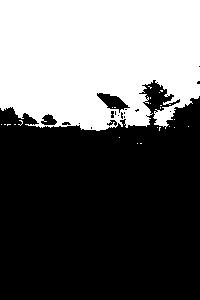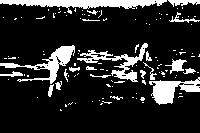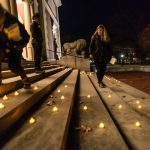 The first days of summer have been uncharacteristically warm and dry at the Bowdoin Scientific Station on Kent Island, where nine Bowdoin students (and one more to arrive this week) are a third of the way into a nine-week field season. The group includes a writer, an installation artist, a photographer, and seven biologists working alongside a team of researchers studying birds, fish, marine invertebrates, and eelgrass. In the coming weeks, the students will haul lobster pots; travel to Machias Seal Island to see the puffin and razorbill nesting colonies; celebrate Canada Day on Grand Manan, and go on a whale watching excursion aboard caretaker Russell Ingalls’s boat. But for now, as BSS Director Damon Gannon and Summer Artist-in-Residence Anne Rothacker ’11 describe in this report, it’s time for dinner.
The first days of summer have been uncharacteristically warm and dry at the Bowdoin Scientific Station on Kent Island, where nine Bowdoin students (and one more to arrive this week) are a third of the way into a nine-week field season. The group includes a writer, an installation artist, a photographer, and seven biologists working alongside a team of researchers studying birds, fish, marine invertebrates, and eelgrass. In the coming weeks, the students will haul lobster pots; travel to Machias Seal Island to see the puffin and razorbill nesting colonies; celebrate Canada Day on Grand Manan, and go on a whale watching excursion aboard caretaker Russell Ingalls’s boat. But for now, as BSS Director Damon Gannon and Summer Artist-in-Residence Anne Rothacker ’11 describe in this report, it’s time for dinner.
Residents of the Bowdoin Scientific Station (BSS) on Kent Island, which is located between New Brunswick and Nova Scotia, are so familiar with the dramatic tides in the Bay of Fundy that they can almost tell time with a tide chart and a glance at the beach. And today, the low tide should occur right at dinnertime. As the tide recedes, they start to listen for the dinner bell.
Sure enough, the bell sounds right at six o’clock. Researchers wade out of the intertidal near the north end of the island, startling flocks of herring gulls with their movement. Nearby, the team studying Leach’s storm-petrels walks through the dappled light of the tree-covered petrel colony, carefully avoiding the birds’ underground nest burrows. The group working on Savannah sparrows in the field that dominates the center of the island approaches the dining area from the other direction, meeting up with scientists who spent the afternoon entering data in the lab, and an artist-in-residence, who just came in from writing a poem on a sunny hilltop. In the kitchen, the cook is ready, carefully placing dishes on the counter as the director and caretaker, sitting at the table, plan an upcoming boat trip to nearby Grand Manan. After a few minutes of frantically loading plates with food, everyone crowds around the small wooden table, bumping elbows as they confer about the island’s ever-changing weather, make jokes, reminisce about island history, and discuss their research.
There’s a lot to talk about. Ten Bowdoin students are working at BSS for the summer, alongside Bowdoin faculty and visiting graduate students and faculty who come from all over North America. These researchers are studying a wide variety of species, including seabirds, songbirds, seagrass, marine invertebrates, and fish.
 The island is home to approximately 15,000 breeding pairs of Leach’s storm-petrels, robin-sized seabirds related to albatrosses that exhibit extreme longevity, living well into their thirties. Once an adult storm-petrel chooses to nest on Kent Island, it will return to the island to raise a single chick with the same mate, in the same nest burrow every summer for the remainder of its life. They feed far offshore, at the edge of the continental shelf, so a storm-petrel raising a chick on Kent Island will make roundtrip flights covering hundreds of miles and lasting up to seven days to catch food for his or her offspring. Storm-petrels only come ashore to reproduce; they spend the rest of the year far out at sea. Some storm-petrels that nest on Kent Island during the northern hemisphere summer have been found in the South Atlantic off southwestern Africa during the winter. Kent Island’s storm-petrels have been the focus of one of the longest-running investigations of any wild animal population, which has resulted in dozens of scientific publications. BSS researchers are currently examining Leach’s storm-petrel’s reproductive rates, the effects of aging on their organ systems, the amount of manmade toxins to which they are exposed and, through the use of biochemical techniques and miniature electronic data loggers, the researchers are tracking their movements and feeding habits.
The island is home to approximately 15,000 breeding pairs of Leach’s storm-petrels, robin-sized seabirds related to albatrosses that exhibit extreme longevity, living well into their thirties. Once an adult storm-petrel chooses to nest on Kent Island, it will return to the island to raise a single chick with the same mate, in the same nest burrow every summer for the remainder of its life. They feed far offshore, at the edge of the continental shelf, so a storm-petrel raising a chick on Kent Island will make roundtrip flights covering hundreds of miles and lasting up to seven days to catch food for his or her offspring. Storm-petrels only come ashore to reproduce; they spend the rest of the year far out at sea. Some storm-petrels that nest on Kent Island during the northern hemisphere summer have been found in the South Atlantic off southwestern Africa during the winter. Kent Island’s storm-petrels have been the focus of one of the longest-running investigations of any wild animal population, which has resulted in dozens of scientific publications. BSS researchers are currently examining Leach’s storm-petrel’s reproductive rates, the effects of aging on their organ systems, the amount of manmade toxins to which they are exposed and, through the use of biochemical techniques and miniature electronic data loggers, the researchers are tracking their movements and feeding habits.
BSS has had a parallel research project on another bird, the Savannah sparrow, a ground-nesting songbird found in grassy fields. Savannah sparrows that nest on Kent Island are thought to winter in the Mid-Atlantic and southeastern U.S. states. Unlike Leach’s storm-petrels, Savannah sparrows only live for a few years but many of the sparrows that are born on Kent Island return here in subsequent years to breed. Faculty and student researchers are studying how young males learn to sing; how experience and fitness affect migration strategies; how weather and climate affect reproductive success; how factors, such as the number of nestlings in a clutch, affect growth and development of the young; and where they spend their winters.
 Throughout its 74-year history, BSS has primarily been an ornithological research center. However, Kent Island offers plenty of material for study. For example, this summer there are several projects focusing on marine organisms, such as eelgrass, soft-shell clams, green crabs, and rock gunnels (a small fish found in the intertidal zone).
Throughout its 74-year history, BSS has primarily been an ornithological research center. However, Kent Island offers plenty of material for study. For example, this summer there are several projects focusing on marine organisms, such as eelgrass, soft-shell clams, green crabs, and rock gunnels (a small fish found in the intertidal zone).
Although BSS is a research station, the work is not entirely scientific; the Station also has an artist-in-residence program. This summer, participants include an installation artist, a photographer, and a writer. This small academic community of 20 people living and working together creates an atmosphere of collegiality, cooperation, and creativity, which benefits scientists and artists alike. Kent Island’s remoteness (it is in Canadian waters, 20 miles off the coast of Maine and 6 miles from the island of Grand Manan) also fosters a strong sense of community, and the lack of modern-day distractions allows the students and faculty to focus on their work.
After almost an hour of trading ideas and talking about research plans around the dinner table, the students and faculty disperse. Some go to the kitchen to wash dishes or bake bread for tomorrow. Others go back to work in the field or return to the lab to update their databases and prepare for tomorrow’s work. The sun won’t set for a few more hours, so those done with the day’s work go out for a walk to South Hill to watch seals and seabirds dart in and out of the crashing surf or turn to the island’s board game collection. Kent Island legend, 90-year-old former director Chuck Huntington, dominates the Bowdoin undergrads at a game of “Trivial Pursuit.”
Once the students finally concede the game, it is time to use the last rays of sunlight filtering through the fog to see their way to bed. After all, the work day tomorrow begins at an hour unknown to most students before their arrival on the island. In this world, where beeping phones and passing cars are replaced by lapping tides and crying gulls, where one gazes out the window at a misty sunset instead of staring at a television, it is easy to fall asleep.
****
See additional photos from this season on Kent Island…

Not sure how else to recommend this to the editors, but a Bowdoin grad was featured on the BET Awards (Black Entertainment Television). Kind of a big deal.
http://betawards.bet.com/video_playlists/geoffrey-canada
My husband Alan & I worked there during the summer of ’86. What a great place! I’d love to bring the kids back to visit some day!
Have a great season!
Jess
From the Editor: Thanks for the tip about Geoff. We’ll let folks know!